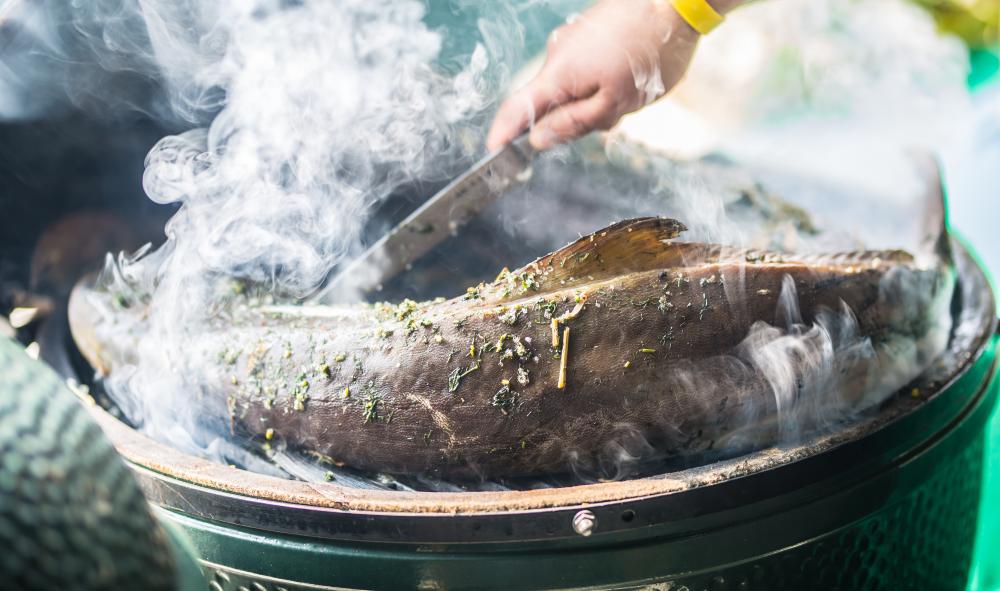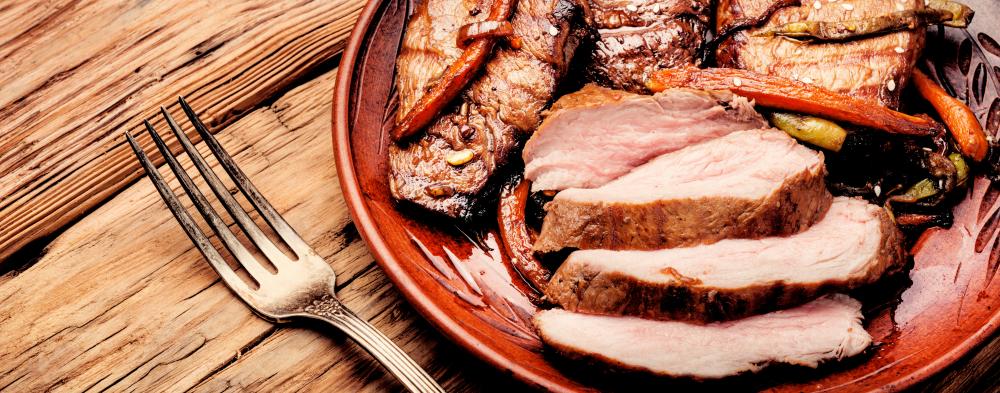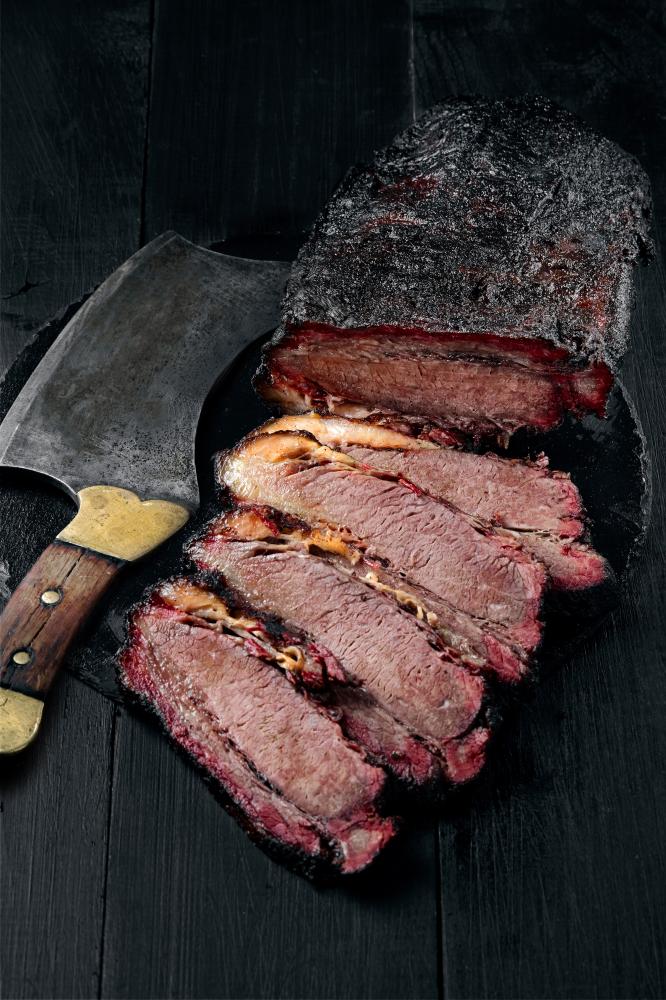
When to Wrap Brisket
At Brisket Pro, we firmly believe that mastering the art of brisket is equal parts science and art. A pivotal technique in this process is knowing precisely when to wrap brisket. This method, often referred to as “The Texas Crutch,” is not just about speeding up the cooking process; it’s about enhancing the flavor, texture, and overall juiciness of your brisket. So, when is the golden moment for this crucial step? Most aficionados agree that the sweet spot is when the brisket’s internal temperature hits between 165-170°F.
Why Wrap Brisket
Combat the Stall
Any brisket master will tell you about the infamous stall. It’s a period during cooking when the brisket’s temperature plateaus, often leading to a longer cooking time. Wrapping acts as a barrier to evaporation, allowing the brisket to push past this stall and continue increasing in temperature.
Enhance Moisture and Flavor
Wrapping brisket also helps lock in those precious juices, ensuring your brisket remains moist. The trapped steam and juices also mingle back into the meat, intensifying the flavor and tenderizing the brisket further. It’s a simple trick that can make all the difference in the final product.
How to Wrap Brisket
Laying out your choice of wrap on a flat surface, place the brisket in the center. For those in the know, there are two primary contenders for wrapping material: aluminum foil and butcher paper. Each has its virtues. Foil creates a tighter seal, potentially speeding up cooking but risking a steamy environment that may soften your bark. Butcher paper, on the other hand, is more breathable, allowing for a bit more smoke penetration and a firmer bark. Whichever you choose, the goal is to wrap it snugly around your brisket, tucking the ends underneath to secure the package.
Material Choices
Aluminum Foil
Aluminum foil is the go-to for many beginners for its simplicity and ease of use. It’s readily available and creates a tight seal around the brisket, trapping in moisture and heat. However, the downside is that it can make the bark soggy if not managed properly.
Butcher Paper
Butcher paper is the preferred wrapping material for brisket aficionados and many top Texas BBQ joints. It strikes a balance between speed and breathability, allowing some smoke to continue flavoring the brisket while preventing excessive drying. Butcher paper also supports the development of a beautifully crusted bark, combining aesthetics with flavor in a way that foil can struggle to match.
Tips and Tricks
While knowing when to wrap brisket and the best materials to use is crucial, there are a few additional tips that can elevate your brisket game. Firstly, always ensure your brisket has reached the correct internal temperature before considering wrapping. Secondly, while wrapped, it’s essential to continue monitoring the temperature to avoid overcooking. Lastly, remember the importance of allowing your brisket to rest after cooking. This resting period lets the juices redistribute throughout the meat, ensuring every slice is as delicious as the last.
- Monitor the brisket’s temperature closely before and after wrapping.
- Choose your wrapping material based on your desired outcome for the bark.
- Allow ample resting time for your brisket post-cook.
At Brisket Pro, our goal is to demystify the process of cooking the perfect brisket. Whether you’re wrapping in foil for a juicy, tender result or opting for butcher paper to achieve that iconic bark, remember that practice makes perfect. Sharing these moments of culinary triumph and challenge enriches our community of brisket lovers. Happy smoking!

Understanding the Brisket Stall
One of the most intriguing phenomena in the world of barbecue is the Brisket Stall Temperature, a stage in the cooking process that often perplexes and frustrates even seasoned grill masters. At Brisket Pro, we delve into this mystifying event to shed some light for both newcomers and experienced cooks alike. The Brisket Stall Temperature usually occurs when the meat’s internal temp hovers around 165-170°F, a scenario where the brisket seems to halt its cooking process, causing concern and impatience among pitmasters.
But why does this happen? The primary culprit behind the brisket stall is evaporation. As the brisket cooks, moisture on its surface begins to evaporate, cooling the meat similar to how sweat cools our bodies. This evaporative cooling effect causes the cooking process to plateau, often leading to hours of waiting for the temperature to rise. It’s a natural part of smoking large cuts of meat but understanding it can turn frustration into fascination.
Tackling the Stall
Wrapping it Up
There are several strategies to overcome the brisket stall, and at Brisket Pro, we’ve experimented with them all to bring you reliable solutions. Wrapping the brisket, known in BBQ circles as the “Texas Crutch,” is a popular method. Whether you choose aluminum foil or butcher paper, wrapping helps to trap moisture, effectively stopping the evaporative cooling process and allowing the Brisket Stall Temperature to finally increase.
Adjust the Heat
Another technique we’ve explored involves adjusting the smoker’s temperature. By slightly increasing the heat, you can counteract the cooling effect of evaporation. It’s a delicate balance, though; too much heat can lead to drying out the meat, while too little will prolong the stall. Through trial and error, we’ve found that a modest temperature bump can make all the difference.
Embracing the Stall
At Brisket Pro, we encourage embracing the Brisket Stall Temperature as part of the barbecue experience. It’s a phase where the collagen in the meat breaks down into gelatin, enriching the brisket with flavor and tenderness. Instead of viewing the stall as a hindrance, see it as an opportunity to let the brisket slowly reach its peak of perfection.
Personal experience has taught us that patience pays off in the world of BBQ. One memorable cook, the stall seemed to last an eternity. Yet, by trusting the process and maintaining a consistent temperature, the brisket emerged from the smoker with an unparalleled depth of flavor and juiciness. It was a testament to the wonders of slow cooking and the magic that happens within the Brisket Stall Temperature window.
By understanding and managing the Brisket Stall Temperature, pitmasters can enhance their skills and produce consistently excellent results. Whether you’re a beginner or a seasoned pro, tackling the brisket stall is a rite of passage that deepens your appreciation for the art of BBQ.
- Recognize the Brisket Stall Temperature as a natural part of the smoking process.
- Consider wrapping the brisket to push through the stall more quickly.
- Adjust smoker temperatures cautiously to avoid overcooking.
- Patience and experience are key to managing the brisket stall effectively.
Understanding Brisket Internal Temp
As a cornerstone of BBQ culture, particularly here in the heart of Texas, mastering the brisket internal temp is akin to a rite of passage. At Brisket Pro, we’re passionate about guiding you through the maze of achieving the perfect brisket. The brisket internal temp is not just a number; it’s the secret sauce to unlocking the full potential of this revered cut. Think of it as the golden key to transforming a tough, fibrous piece of meat into a tender, melt-in-your-mouth masterpiece.
When smoking brisket, the brisket internal temp to aim for is 195°F to 205°F. This range is considered the sweet spot for breaking down the collagen, fats, and connective tissues that make brisket tough when undercooked. Each brisket is unique, and factors like size, fat content, and even the weather can affect cooking times, making it crucial to monitor the brisket internal temp closely rather than relying solely on cooking time.
It’s important to note that the journey to the ideal brisket internal temp is often marked by “the stall,” a period when the meat’s temperature plateaus due to evaporative cooling. Many pitmasters wrap their brisket in butcher paper or aluminum foil during this phase, a technique known as the Texas Crutch, to push past the stall and keep the brisket on track to reach its perfect internal temperature.
Tips for Achieving the Perfect Brisket Internal Temp
Through years of trial, error, and success, I’ve gathered a trove of insights on how to maintain the brisket internal temp for that ideal brisket. Here are some tips to ensure you hit the mark every time:
- Invest in a reliable meat thermometer to keep tabs on your brisket’s progress without having to constantly open the smoker or grill, which can lead to heat loss.
- Patience is key. Rushing your brisket will only lead to disappointment. Allow it to slowly reach the desired brisket internal temp for the best results.
- The crutch isn’t a crutch. Wrapping your brisket can help you overcome the stall more effectively, ensuring that your brisket internal temp rises steadily to the target range.
- Let it rest. Once your brisket reaches the ideal brisket internal temp, giving it time to rest before slicing allows the juices to redistribute, ensuring every bite is as succulent as the last.
In my journey from novice to brisket pro, I’ve learned that each brisket tells its own story through its texture, flavor, and, crucially, its internal temperature. The difference between a good brisket and a great one often comes down to the care and attention paid to monitoring and managing the brisket internal temp.
Leon’s Personal Anecdotes
One memorable summer, I found myself in the midst of a brisket challenge with fellow pitmasters. Despite the sweltering heat and the pressure of competition, I adhered to my principles, focusing meticulously on the brisket internal temp. That day, not only did my brisket turn out to be a crowd-pleaser, but it also taught me that consistency in monitoring and adjusting the brisket internal temp, even in less-than-ideal conditions, is crucial to brisket perfection.
Another insight I’ve gained is the importance of letting the brisket rest. It was a hard-learned lesson when, in my early days, I eagerly sliced into a brisket too soon after pulling it from the smoker, only to find that the moisture I’d worked so hard to preserve had escaped. Now, I preach the gospel of patience, ensuring that once the brisket internal temp is right, the brisket gets ample time to rest.
At Brisket Pro, our mission goes beyond just sharing recipes or cooking times. It’s about imparting the wisdom of experience, the subtleties that turn cooking into art. And at the heart of this artistry is an understanding and respect for the brisket internal temp. So, whether you’re smoking your first brisket or your fiftieth, remember that achieving the perfect brisket internal temp is a journey of passion, patience, and persistence.

When should you wrap a brisket?
At Brisket Pro, we often find ourselves deeply immersed in the nuances of cooking the perfect brisket. One of the pivotal moments in this process is deciding when to wrap the brisket. The ideal time to embrace the “Texas Crutch” is when the internal temperature of the brisket reaches between 165-170°F. By this stage, the brisket has absorbed a beautiful smoke flavor, but wrapping it can help push through the stall and ensure it remains moist and tender. Remember, every piece of meat can be a bit different; so, while temperature is a great guide, also pay attention to the texture and appearance. It should have a nice crust formed by now, which wrapping will help to preserve while it continues to cook.
What happens if you wrap brisket too early?
Wrapping a brisket too early is a common concern among barbecue enthusiasts. When you wrap the brisket before it reaches the recommended temperature range of 165-170°F, you risk missing out on achieving a deep, well-developed bark and the rich, smoky flavor that comes with adequate smoke exposure. The brisket needs time to form that crusty exterior, which is essentially the result of the Maillard reaction and smoke particles adhering to the surface. If wrapped too soon, the brisket steams in its own juices, softening the bark before it fully forms. It’s like putting a raincoat on before you’ve had the chance to dance in the rain; you’ll stay dry, but you’ll miss out on the full experience.
How long should brisket rest before wrapping?
When we talk about the brisket resting before wrapping, what we’re really addressing is the importance of timing in the smoking process. There isn’t a one-size-fits-all answer, as it largely depends on the specific cooking method and individual brisket. However, the concept of resting usually applies after the brisket has finished cooking, rather than before wrapping. After cooking, allowing the brisket to rest for at least 30 minutes to an hour ensures the juices redistribute throughout the meat, making every bite succulent. If you’re referring to a pause before wrapping during cooking, the key is to wait until it reaches the correct internal temperature range (165-170°F) before wrapping. This ensures maximum smoke penetration and proper bark formation before the brisket enters its next cooking phase.
How long to cook brisket after wrapping at 225?
Cooking a brisket at a low and slow temperature of 225°F is a traditional method many of us at Brisket Pro swear by. After wrapping the brisket, you can generally expect it to take several more hours to reach the desired internal temperature of 195-205°F, which is considered the sweet spot for optimal tenderness and moisture. The exact time, however, can vary widely based on the size and thickness of the brisket, as well as your specific smoker’s characteristics. A good rule of thumb is to plan for an additional 1.5 to 2 hours of cooking time per pound after wrapping, but always use a meat thermometer to check for doneness rather than relying solely on time. Remember, the magic of barbecue isn’t in haste; it’s in the slow, rewarding journey to perfection.
Brisket Resources
- When to Wrap a Brisket in Foil – BBQ Superstars – Learn about the optimal time to wrap brisket to enhance flavor and juiciness.
- When to Wrap a Brisket – The Spruce Eats – Discover the science behind wrapping brisket and how it can combat the stall.
- Brisket Wrap Methods – Smoked BBQ Source – Explore the differences between using aluminum foil and butcher paper to wrap brisket.
- Texas Crutch: BBQ and Grilling Super Power – Amazing Ribs – Understand the benefits of wrapping brisket and how it can help combat the stall temperature.

